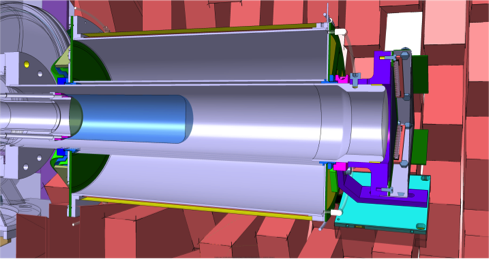General Presentation
MINOS, acronym for MagIc Numbers Off Stability, is a new apparatus dedicated to in-beam nuclear structure experiments with low-intensity exotic beams in inverse kinematics at intermediate energies above 150 MeV/nucleon. The detector is to be used at RIKEN/RIBF, today’s world leading Radioactive Ion Beam facility. The device is composed of a thick liquid hydrogen target coupled to a compact time projection chamber serving as a vertex tracker. Either used for in-beam gamma spectroscopy of bound excited states in conjunction with DALI2 or/and invariant-mass spectroscopy of unbound states at SAMURAI, MINOS aims at improving the luminosity by a significant factor (factor 5 in statistics) compared to standard solid-target material experiments while improving experimental resolutions.
Figure 1: Technical drawing of MINOS inserted inside the DALI2 array.
Atomic nuclei are few-body systems mainly governed by the strong force and quantum mechanical laws. They are composed of nucleons interacting through the in-medium nuclear forces. The nuclear shell gaps represent the backbone of nuclear structure and are a direct fingerprint of the nuclear interactions. Magic numbers of nucleons are well established for stable nuclei: 2, 8, 20, 28, 50, 82, 126 but are known not to be universal over the nuclear chart. Indeed, the nuclear shell structure is known to change, sometimes drastically, with the number of protons and neutrons, revealing how delicate the arrangement of interacting nucleons is.
New shell closures or strong shell reordering may occur in several regions of the nuclear chart at the limit to be reached with current setups and beam intensities. MINOS aims at contributing to this quest of the nuclear shell structure far from stability.
MINOS has been conceived and built at the CEA Science Matter Department and is supported by an ERC Grant (Principal Investigator: A. Obertelli). It is currently hosted by the Spin-Isospin laboratory (Chief Scientist: T. Uesaka) of the RIKEN Nishina Center.




